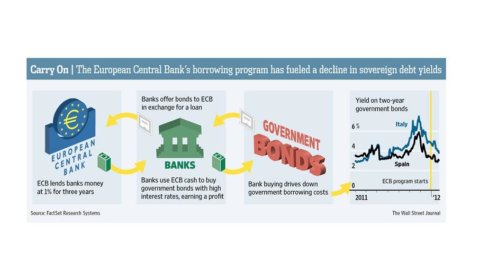On 29 February, the European Central Bank (ECB) will decide how to deal with the second LTRO (Long Term Refinancing Operation), i.e. it will have to establish the methods and timing of the new long-term loan to be granted to European banks to avoid the credit crunch risk. The latest study by the American investment bank, Morgan Stanley, estimates that the second wave of liquidity will range between a value of 200 and 500 billion euros. This figure, plus 100 billion euros taken from the first Ltro, will probably be spread over a three-year scheme. According to the Reuters consensus, the final total figure would be 470 billion euros.
The first Ltro (December 21) was 489 billion euros in the form of 3-year loans for 523 European banks – 190 billion of the total came from the issuance of new money. The happy invention of SuperMario Draghi has allowed the bags to never relive the days of deep reds in the last two months as they were seen at the end of 2011. Markets stabilized and tensions eased for many banks in peripheral countries.
According to Morgan Stanley, the beneficiaries of the second Ltro will be mainly Spanish and Italian banks and most of the package will be invested in government bonds. Analysts also predict that the institutions of our country will request for a higher sum than the first tranche, also following the EBA's capitalization requests.
Yet Ms is not confident enough. According to the US bank, Ltro2 will help the deleveraging process in the Eurozone but it won't be enough to improve conditions for creditors. Credit will continue to tighten in peripheral countries and more targeted actions may be needed to stimulate lending to customers and businesses.
Indeed, the Ltro2 has stabilized the markets, but it hasn't changed any forecasts on the growth of the eurozone countries. 9% of European companies recorded, in the last quarter of 2011, profits lower than expected and the constant uncertainties on the situation in Greece do not improve expectations.
The wave of liquidity supported by ECB President Draghi has curbed speculation and stabilized the financial markets. Now, however, there is a need for concrete reforms to aim for the recovery of the real economy. And it seems that with the letter from the 12 heads of state to the European Commission we are heading in the right direction.
What is the lter
The acronym means the Long-term refinancing operations, or a long-term financing transaction. The European Central Bank provides eurozone banks with a large sum of liquidity, at an interest rate of 1%, in the form of loans with a maturity of 3 years. Credit institutions use these funds at a time when it is difficult for them to finance themselves on the capital market, given the current financial crisis. This money should be used to lend to customers and businesses, and thus avoid a credit crunch in the economy.
However, as Ms' own analysis reveals, most of the funds will be invested in government bonds, a safe haven with decidedly high yields at the moment. Just think that Italian 3-year bonds today yield 3,4%. This means that a bank that has obtained 100 million at an interest rate of 1%, if it invests it in three-year bonds, will have earned 240 million euros in three years. And without running any risk.




